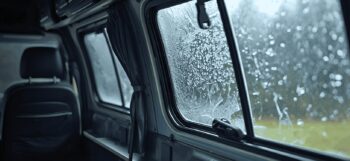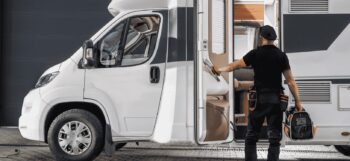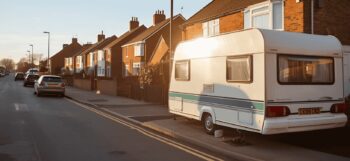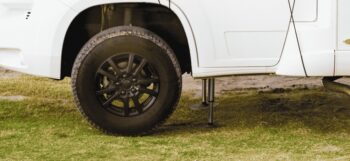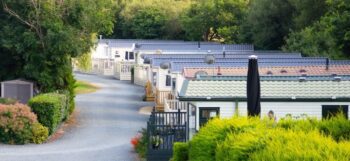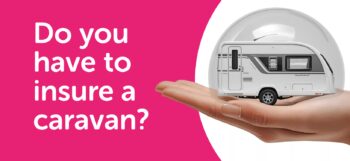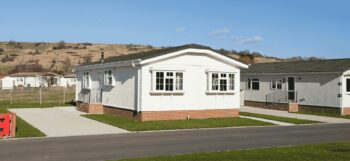We all hope for dry, sunny weather when we venture out for a bit of rest and recouperation in our motorhome, campervan, or touring caravan. But sometimes blistering hot, face melting conditions can make for an uncomfortable and even unbearable experience, and spoil even the most well-planned adventure.
You’ll be pleased to learn that there are some simple things that you can do to keep both you and your outfit from overheating.
Here are our top tips for keeping you and your outfit cool during a summer scorcher.
Park in the shade
The most obvious thing to do when pitching up is to pick a spot which is shaded by surrounding trees. However, this may not always be possible if you have pre-booked and have been allocated a pitch. Some campsites also have rules about which way you park your outfit, for example some campsites like all habitation doors to be facing the same way for privacy reasons, which may also affect the amount of direct sunlight your van will be exposed to.

Get the air flowing
Get your windows open. Opening windows on opposing sides of your outfit will encourage the circulation of air during hot weather and can also help prevent condensation forming during the early hours. Heat rises, so getting your pop-top roof up or keeping your roof hatches open will allow the escape of built-up heat. Flies and other winged insects can be a nuisance, especially if you are in the countryside. There are lots of fly screens on the market which can help to keep them outside, where they should be. Check out fly screens from Leisure Direct.
Stay under cover
According to this article from Russells Curtains and Blinds, around 30% of unwanted heat enters your home through windows that face the sun during peak hours. The same principal applies to motorhomes and caravans.
Large windows such as windscreens generate a lot of heat and on hot days, you’ll soon notice sitting in your outfit can become akin to sitting in a greenhouse. To help combat this, keep curtains or blinds closed, and ideally use curtains that are made from lighter coloured fabrics, as lighter colours tend to be less heat absorbing. Using reflective or thermal blinds can also help.
Cook outside
Never underestimate how much heat is transferred during cooking. Where possible, cook outside on a portable camping stove, BBQ or firepit.
Firepits and BBQs should be elevated from the ground to prevent scorching and should never be left unattended. Always make sure you have water or a fire extinguisher to hand, and put the fire out when no longer required. Always check whether BBQs or firepits are permitted at the campsite you're staying on. This article from Goboony has some hints and tips for outdoor cooking. You can even make tea or coffee outside. Read it here.

Use an awning or sun canopy
In addition to extending your living space, awnings also provide a shaded area around your habitation door. Traditional canvas awnings, attached via a C-rail, are similar to tents. These types of awnings can get a little stuffy during hot weather, but unzipping windows and door panels allows air to circulate around the awning. Fiamma make a range of wind-out awnings for motorhomes, campervans, and touring caravans. Wind-out awnings are fixed to the side of the outfit and wound out using a winding handle. Canopies are another option for creating shade and are good for campervans as they have a much smaller pack size and weight compared to that of a traditional awning. The 2.5m Vango Airbeam Sky Canopy has a single inflatable beam and can be put up in minutes.

Park high up or near to the coast
If you’re looking for a park-up, choosing a spot at a higher elevation will often be cooler. It is said that for every 100 metres climbed the temperature drops up to 1°[i]. This is due to air pressure and water vapour content. And remember, the higher up you are the breezier it can be.
Parking near a coastline can often be cooler, as sinking air and high pressure over water creates what we know as a ‘sea breeze’. Parking near a body of water such as a lake or river can also feel cooler, although water attracts midges and mosquitos, so be prepared for the odd bite.
Pack a fan
Investing in a fan can be a godsend when things hot up. There are many 12v and USB rechargeable fans on the market which are small enough to store in even the smallest of campervans. Clip fans are a good option as they can be positioned where you want them, to feel the maximum benefit. The CAVN USB Desk Fan, Rechargeable Mini Portable Clip Fan has 4 speeds, 360° oscillation and is an ‘Amazon choice’ product.
Use LEDs
Lights give off heat, in varying degrees, depending on the type of bulb you are using. LEDs give off a fraction of the heat of incandescent (filament), fluorescent and halogen bulbs. Switching to LEDs is not only more energy-efficient, but it will keep your outfit cooler in the summer, too. However, if LEDs are left running in an enclosed space, with no ventilation, this can cause them to emit heat beyond their usual range.
Switch electrical items off
Heat generating personal gadgets, such as TVs or laptops, should be switched off when not in use. Your fridge alone will give off a lot of heat, as heat is a by product of the refrigeration process, and in hot weather, this may effectively turn your unit into a mobile sauna.
Remember, it is not a good idea to position the back of your fridge/vents to face the sun as the hotter it gets, the harder your fridge will have to work to keep cool. If your fridge does become hot, check the vents to see if they have become blocked and remedy as required. As an additional measure, you can shield your fridge from direct sunlight by affixing a sheet of radiator foil to the side of your outfit with magnets. Magnets can cause horrific damage to the body if swallowed, so always keep magnets away from children. This article on magnet safety is worth a read.

Air conditioners
The most effective way to keep your unit cool is with an air conditioning unit. Air conditioning units work by lowering the temperature and humidity levels inside a motorhome or caravan. There are two types of units; roof mounted and under bench units, but the downside is they are expensive to purchase, install and run. You can get portable units which are comparable in output, but these tend to take up floor space. On the plus side, you can take them out of your unit when they aren’t required.
Sleep outside
It may not be the obvious thing to do when you have a bed in your outfit, but sleeping outside can be a great way to keep cool on the hottest of evenings. If you have an awning, take advantage of it. Especially if you are holidaying abroad, where the nights seem to be much less cold.

Stay hydrated
As well as keeping cool, you should also make sure you stay hydrated.
Heatstroke occurs when the body overheats, usually because of prolonged exposure to the sun, or physical exertion in high temperatures. During an episode of heatstroke, body temperature rises to 104 F (40 C) or higher from the average core temperature, which is typically 98.6 F (37 C). During periods of extreme heat, it is normal to feel like you are burning up. But if you can’t cool yourself down within 30 minutes, and start to feel tired, dizzy, or sick, you may need medical attention. The NHS website has tips for dealing with heatstroke.
To stay hydrated, start your day with a glass of water and make sure you always have water with you, to sip throughout the day. For every cup of tea, coffee, or alcoholic beverage drunk, you should follow by drinking a glass of water. Coffee, tea, alcohol, and even fizzy drinks are diuretics, which expel water from the body, so drinking too many can have a dehydrating effect on the body.
To determine if you’re drinking enough water, pay attention to the colour of your urine. Dark yellow or amber means you are dehydrated and need to up your intake of liquids. If you are well hydrated your urine will be light in colour. Other signs of dehydration can include going to the toilet less often than usual, feeling dizzy or lightheaded, feeling tired, a dry mouth, lips and tongue.

Don’t forget the dog
If you are taking your dog with you don’t forget that, like cars, it is extremely dangerous to leave your dog in a hot motorhome, campervan, or caravan. Just because they have more space it doesn’t reduce the risk of dogs over-heating.

For more helpful guides, visit our Useful Information page or why not read some of our previously posted articles.
Disclaimer: The sole purpose of this article is to provide guidance on the topic covered. This article is not intended to give legal advice, it should not be relied upon. It should not be regarded as a comprehensive statement of the law and/or market practice in this area. We cannot guarantee the completeness or accuracy of the information contained in the external links, which were live at the date of publication.



